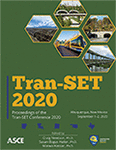Tran-SET 2020
Perception, Awareness, and Importance of Preparing for Connected and Automated Vehicle (CAV) Technologies: A Survey of Louisiana Organizations
Publication: Tran-SET 2020
ABSTRACT
There is an immense amount of activity surrounding connected and automated vehicle (CAV) technology deployment. This paper briefly reviews the main research, administrative, and legislative initiatives Louisiana has taken in preparation of these technologies. To encourage wider participation in these activities, a brief electronic survey was developed and disseminated to 273 Louisiana organizations. The purpose of the survey was to initially engage these organizations under the context of CAV planning and gauge their awareness, perception, and viewed importance of planning for CAV technologies. 117 participants completed the survey. Low awareness and perception by economic development, freight, and transit organizations—coupled with low levels of perceived importance of planning by freight and transit operators—indicate areas of concern. Wide variability in which organizations are currently preparing for CAV technologies—including the low percentage reported by state agencies (21.1%), local agencies (15.8%), and nonprofits (8.3%)—is also a potential concern.
Get full access to this article
View all available purchase options and get full access to this chapter.
ACKNOWLEDGEMENTS
The presented work was funded by a grant from the U.S. Department of Transportation’s University Transportation Centers Program – and with contribution from PTV Group, Capital Region Planning Commission, and Louisiana State University. The content and views are solely the authors.
REFERENCES
Chauhan, A. (2018, Feb.). CAV Technology Team: Updates & Moving Forward. Presented at the Louisiana Transportation Conference 2018, Baton Rouge, LA.
FHWA (Federal Highway Administration). (2018). Status of the Nation’s Highway, Bridges, and Transit: Conditions and Performance, Part III: Highway Freight Transportation. Report to Congress, U.S. Department of Transportation, Washington, D.C.
Hallmark, S., Veneziano, D., and Litteral, T. (2019). Preparing Local Agencies for the Future of Connected and Autonomous Vehicles. Report No. MN/RC 2019-18, Minnesota Department of Transportation: Local Road Research Board, St. Paul, MN.
Kockelman, K., Boyles, S., Avery, P., Claudel, C., Bansal, P., Loftus-Otway, L., and Clements, L. (2016). Bringing Smart Transport to Texans: Ensuring the Benefits of a Connected and Autonomous Transport System in Texas. Report No. FHWA/TX-16/0-6838-2, Texas Department of Transportation, Austin, TX.
L.A. Legis. Assemb. (2018). Act No. 310. Reg. Sess. 2018.
L.A. Legis. Assemb. (2019). Act No. 232. Reg. Sess. 2019.
Melson, C. (2019). Analysis, Modeling, and Simulation (AMS) Case Studies of Connected and Automated Vehicle (CAV) Implementations Specific to the Southcentral Region. Project 19ITSLSU06, Transportation Consortium of Southcentral States (Tran-SET), Baton Rouge, LA. Assessed Nov. 15, 2019. https://transet.lsu.edu/wp-content/uploads/sites/16/2019/08/19ITSLSU06-PIF.pdf
NACo (National Association of Counties). (2019). Connected and Automated Vehicles Toolkit. National Association of Counties, Washington, D.C. Accessed Nov. 15, 2019. https://www.naco.org/resources/featured/connected-autonomous-vehicles-toolkit
NGA (National Governors Association). (2018). Governor’s Staying Ahead of the Transportation Innovation Curve: A Policy Roadmap for States. National Governors Association, Washington, D.C. Accessed Nov. 15, 2019. https://www.nga.org/wp-content/uploads/2018/07/Transportation-Innovation-Roadmap-Final-Hi-Res-for-Posting-Online.pdf.
Pettigrew, S., Talati, Z., and Norman, R. (2018). The Health and Benefits of Autonomous Vehicles: Public Awareness and Receptivity in Australia. Australian and New Zealand Journal of Public Health, 42(5), pp. 480-483.
Rogers, E.M. (2010). Diffusion of Innovations. Simon and Schuster.
Sherif, I., Osman, O., Codjoe, J., Mousa, S., and Bakhit, P. (2018). Development of a Simulation Test Bed for Connected Vehicles using the LSU Driving Simulator. Report No. 586, Louisiana Transportation Research Center, Baton Rouge, LA.
Smith, S., Koopman, J., Rakoff, H., Peirce, S., Noel, G., Eilbert, A. and Yanagisawa, M. (2018). Benefits Estimation Model for Automated Vehicle Operations: Phase 2 Final Report. Report No. FHWA-JPO-18-636, Joint Programs Office for Intelligent Transportation Systems, Washington, D.C.
Walker, S. (2018). Report of the Governor’s Steering Committee on Autonomous and Connected Vehicle Testing and Deployment. State of Wisconsin, Madison, WI.
Wilmot, C. and Greensword, M. (2016). Investigation into Legislative Action Needed to Accommodate the Future Safe Operation of Autonomous Vehicles in the State of Louisiana. Report No. 571, Louisiana Transportation Research Center, Baton Rouge, LA.
Information & Authors
Information
Published In
Tran-SET 2020
Pages: 18 - 27
Editors: Craig Newtson, Ph.D., New Mexico State University, Susan Bogus Halter, Ph.D., University of New Mexico, and Marwa Hassan, Ph.D., Louisiana State University
ISBN (Online): 978-0-7844-8330-5
Copyright
© 2021 American Society of Civil Engineers.
History
Published online: Jan 12, 2021
Authors
Metrics & Citations
Metrics
Citations
Download citation
If you have the appropriate software installed, you can download article citation data to the citation manager of your choice. Simply select your manager software from the list below and click Download.
